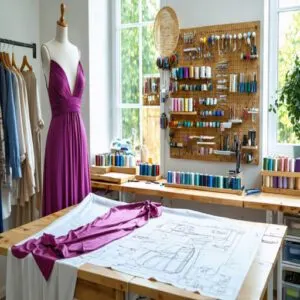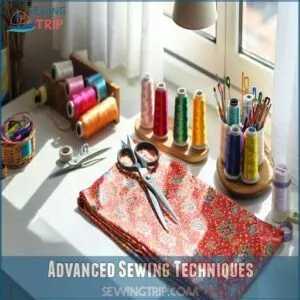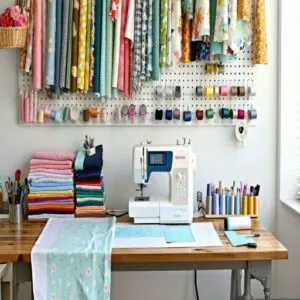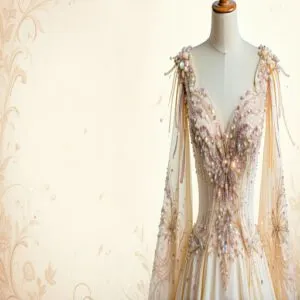This site is supported by our readers. We may earn a commission, at no cost to you, if you purchase through links.

It’s about mastering clever techniques like dart manipulation, custom blocks, and adapting patterns to fit your vision (and let’s face it, your measurements).
You’ll learn to analyze fabric properties—because wool behaves nothing like silk—and combine that with skills like adding texture through layering or refining seam placement for tailor-made precision.
Sprinkle in decorative flourishes like embroidery or beading, and your designs will shine, they’ll stand out like a pop of neon thread on a rainy day.
Ready to stitch perfection? Let’s get started!
Table Of Contents
Key Takeaways
- Master dart manipulation to shape fabric creatively and achieve a perfect fit.
- Customize patterns by combining basic blocks with advanced techniques like pattern grading and fabric adaptation.
- Experiment with fabric textures, layering, and embroidery to add depth, style, and personality to your designs.
- Use precise tools and advanced sewing techniques for clean finishes, complex designs, and professional results.
Advanced Sewing Techniques
You’ve mastered the basics, so now it’s time to level up with advanced sewing techniques that add flair and polish to your work.
From creating intricate embroidery designs to experimenting with tricky fabrics, these skills will make your projects stand out like a handmade masterpiece.
Mastering Embroidery Stitches
Mastering embroidery stitches adds serious flair to your projects. Ready to level up? Start here:
To get started with advanced embroidery, learning various embroidery stitches is essential for creating intricate designs.
- Experiment with stitch variations like bullion knots or fishbone stitches.
- Match thread selection with your design for standout results.
- Explore embellishment methods like layering stitches for depth.
- Use precise needle techniques for clean finishes.
- Customize embroidery patterns to make each stitch your own.
Working With Different Fabrics
Understanding fabrics transforms your sewing.
Ever tried working with silk and felt like it had a mind of its own? That’s the beauty of combining textile science and garment construction methods.
Learn how fiber blends, weave types, and yarn weight impact texture analysis.
Mastering advanced sewing techniques is essential for working with various fabrics.
Smart fabric selection means your sewing pattern making stays sharp, even with tricky textiles like chiffon or denim.
Creating Unique Textures and Effects
Why settle for flat designs when you can create magic with depth and texture?
Try these:
- Fabric layering to add subtle dimension.
- Thread mixing for unique color blends.
- Stitch combining to explore new embroidery patterns.
- Texture techniques like raised embroidery for dramatic effects.
- Playing with tension to give stitches personality.
Experiment boldly—it’s where creativity shines brightest!
Sewing Pattern Basics
If you’ve ever been puzzled by pattern pieces or unsure about fabric choices, you’re not alone—it’s all part of sewing’s quirky charm.
Understanding how these elements work together will reveal endless creative possibilities (and save you from a few “what was I thinking?” moments).
Understanding Pattern Pieces
Think of pattern pieces like a road map to your sewing project.
Nail the seam allowance (it’s your safety margin), match those notch placements, and follow the grain line for balanced drape.
A solid pattern layout keeps your fabric cutting precise.
Master these steps, and you’re on track to conquer pattern drafting and flawless garment construction techniques.
Utilizing sewing pattern pieces effectively is essential for achieving professional results in your sewing projects.
Choosing The Right Fabric
Choosing the right fabric is like picking the perfect partner—it defines everything!
Focus on fabric selection by analyzing the texture and understanding fiber content.
Pay attention to drape characteristics, as they’ll make or break your design.
Explore weave types and modern textile fabrication methods to enhance shape and style.
Experiment with fabric sculpting to discover creative potential.
Custom Pattern Making
Custom pattern making lets you turn your unique design visions into reality with precision and a personal touch.
From creating basic blocks to experimenting with dart manipulation, you’ll gain the skills to craft garments that fit like a dream and reflect your style.
Creating Basic Blocks
Starting fresh with sewing pattern design? Building pattern blocks is your ultimate shortcut. These slopers are your foundation for creative freedom and accurate fit.
Understanding basic pattern making is essential for a strong start.
Here’s how:
- Measure yourself precisely—because let’s skip the "oops, it’s too tight" moment.
- Use block construction methods for flexibility in block modification later.
- Match your fabric selection to your project’s needs.
Mastering Dart Manipulation
You’re ready to level up from basic blocks? Let’s talk dart manipulation. It’s all about shaping fabric to fit curves beautifully.
Dart rotation is a game-changer, letting you move darts anywhere for creative freedom—think haute couture patterns!
| Technique | Best Use | Tools Needed | Complexity Level | Key Tip |
|---|---|---|---|---|
| Dart Rotation | Creative designs | Pattern drafting tools | Medium | Visualize curved seams before cutting |
| Slash & Spread | Adding flair (gathers/volume) | Scissors, rulers | High | Keep fabric drape consistent |
| Pivot Method | Quick dart adjustment | Transparent ruler | Easy | Focus on sewing precision |
| Multiple Darts | Advanced shaping | French curve, paper | High | Balance dart placement evenly |
| Hidden Darts | Seamless appearance | Fabric marking tools | Medium | Use lightweight fabrics for sleek results |
Adapting Patterns for Different Fabrics
Fabric selection isn’t just about pretty prints—it’s where sewing magic begins.
Think textile science: Analyze the weave, thread count, and fiber blending.
Lightweight fabrics need sewing pattern alteration; stretch knits? Adjust ease.
Use pattern grading systems for accuracy.
Garment construction tips: Test drape before cutting!
To achieve professional results, utilizing sewing pattern software is essential.
Adapting fabrics transforms beginner work into pro-level masterpieces.
Fitted patterns demand precision.
Advanced Pattern Modification
When you modify a sewing pattern, you’re not just tweaking measurements—you’re creating something truly your own.
Whether you’re adjusting for a perfect fit or adding intricate details, it’s where creativity and precision collide.
Altering Patterns for Fit
Nailing a perfect fit begins with accurate body measurements and patience.
Tweaking sewing patterns can feel intimidating, but it’s empowering once mastered. Understanding pattern adjustments is essential for achieving a flawless fit.
- Adjust armholes and shoulders for a polished look.
- Use pattern grading systems to fine-tune size modifications.
- Test garment fitting techniques with muslins to avoid costly mistakes, which is a crucial step in mastering sewing patterns.
Adding Decorative Elements
Let’s make your patterns pop!
Add flair with fabric embellishments like beaded accents or lace applications for that wow factor.
Try ribbon embroidery or playful sewing trims to elevate details.
Incorporating beaded accents can add a touch of sophistication to your designs.
These advanced sewing techniques bring personality to your work while turning sewing pattern alterations into art.
A little sparkle goes a long way in refined garment construction!
Working With Complex Designs
Tackling complex designs feels like solving an artistic puzzle.
With pattern engineering and dimensional construction, you bring couture sewing to life.
Here’s how to up your game:
- Layer designs for depth using texture manipulation.
- Combine darts and pleats for custom shapes.
- Experiment with complex fabrication materials.
- Test advanced sewing techniques like curve refinement.
- Use sewing pattern drafting for innovation.
Mastering Sewing Skills
You’ve worked hard to get the basics down, but now it’s time to sharpen those skills and think like a pro.
From tackling tricky fabrics to nailing clean seams, mastering advanced techniques will make your projects look polished and ready for the runway.
Developing Industry-Standard Techniques
Mastering industry-standard techniques isn’t just about skill—it’s about thinking like a pro.
Choose fabrics wisely using textile science principles. Precision with your sewing notions guarantees clean lines. Understand pattern grading for perfect sizes.
Need better structure? Study garment construction details. Treat tools like allies in fashion design principles, and embrace the finesse of couture sewing.
| Skill | Why It Matters | Quick Tip |
|---|---|---|
| Fabric Selection | Ensures proper drape | Test swatches before committing |
| Pattern Drafting | Builds design accuracy | Use transparent rulers for clarity |
| Garment Fitting | Achieves perfect sizing | Adjust darts and seams as needed |
Troubleshooting Common Mistakes
Mistakes happen, but don’t let them sew chaos into your projects!
Here’s how to troubleshoot common sewing mistakes:
- Wrong needle size? Switch it up before fabric damage strikes.
- Thread tension off? Adjust for puckering-free seams.
- Skipped fabric pre-wash? Expect shrinkage.
- Missed pressing seams? Goodbye, polished finish!
- Fabric issues? Choose wisely to avoid garment fails.
Refining Skills for Professional Results
You’ve tackled common errors, so now it’s all about leveling up with professional touches.
Precision cutting sets the stage, while expert fitting transforms good garments into masterpieces.
Focus on advanced finishing techniques and professional trimming for that clean, high-end look.
Master tailoring lies in mastering sewing techniques, perfecting garment construction, and refining pattern making.
To achieve professional results, understanding advanced sewing techniques is essential for success.
Success lies in practice, patience, and sharp scissors!
Frequently Asked Questions (FAQs)
What is the difference between beginner and advanced sewing patterns?
Beginner sewing patterns keep it simple—fewer pieces, straightforward instructions, and basic skills.
Advanced patterns dive deeper with intricate details like dart manipulation, custom fits, and challenging fabrics, demanding precision, creativity, and a good dose of patience.
What is the difference between basic and advanced sewing techniques?
Think stitching straight lines is tough?
Advanced sewing kicks it up with French seams, bias binding, and dart magic.
It’s the difference between sewing a tote and tailoring a jacket that fits like a glove.
What are the features of advanced sewing machines?
Advanced sewing machines pack features like automatic thread cutters, programmable stitch patterns, touchscreen displays, embroidery capabilities, and adjustable speed control.
They’re designed to handle complex projects, save time, and give you pro-level precision.
What is sewing for beginners?
Diving into sewing feels like opening a treasure chest of creativity.
Start with beginner patterns labeled "easy," practice straight stitches, and get comfy with your machine.
Don’t stress over mistakes—they’re just stitches in your learning story.
What is sewing and techniques?
Sewing lets you turn fabric into something uniquely yours.
Techniques include basic stitches, hemming, zippers, and pleats.
Dive deeper with French seams, darts, or pattern adjustments to fit your style perfectly—it’s hands-on creativity at its best!
What can I learn from sewing?
You’ll pick up skills to create and customize clothing, fix wardrobe malfunctions, and design from scratch.
Plus, it’s a stress reliever, a creative outlet, and a ticket to making perfectly fitted outfits.
What makes a sewing pattern advanced?
Ever wonder why some patterns seem intimidating?
Advanced sewing patterns challenge you with intricate designs, tons of tiny details, and techniques like darts, pleats, and linings.
They demand precision, problem-solving, and a keen eye for detail.
What are advanced sewing techniques?
Master advanced sewing techniques like sewing invisible zippers, creating French seams, crafting collars, and sewing scalloped edges.
Experiment with stretchy knits, applying bias binding, and mastering darts for a custom fit that screams professional craftsmanship.
What is the hardest thing to sew?
The hardest thing to sew?
Probably a custom jacket.
Precision is everything—perfect seams, sharp lapels, smooth lining.
Add tricky fabrics like wool or silk, and yeah, it’s a project that truly tests your patience and skill.
Can you make a living from sewing?
Where there’s a will, there’s a way!
You can absolutely make a living sewing—design custom garments, sell handcrafted items, teach classes, or repair clothes.
Tap into your creativity and market your skills wisely!
Conclusion
So, what’s stopping you from diving into exploring advanced sewing pattern making and creating your dream designs?
With techniques like dart manipulation, custom blocks, and mastering fabric differences, you can transform your ideas into pieces that fit perfectly and stand out.
Play with textures, refine seam placements, and sprinkle in some embroidery or beading to add personality.
Your creativity is the limit—so grab that fabric and start stitching perfection. Your next masterpiece is waiting!












